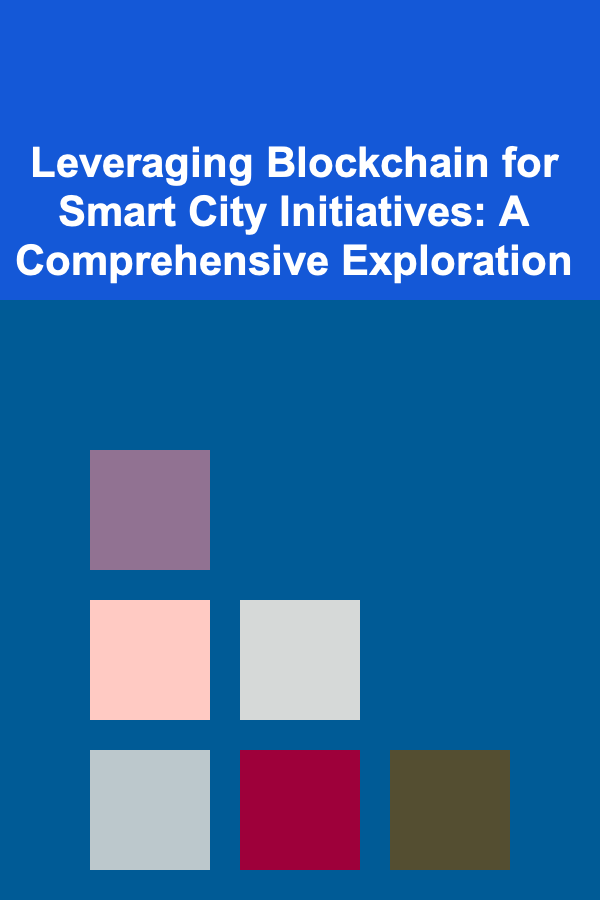
Leveraging Blockchain for Smart City Initiatives: A Comprehensive Exploration
ebook include PDF & Audio bundle (Micro Guide)
$12.99$8.99
Limited Time Offer! Order within the next:

The vision of a smart city, where technology seamlessly integrates with urban infrastructure to enhance efficiency, sustainability, and quality of life for its inhabitants, is rapidly transitioning from concept to reality. Driven by advancements in the Internet of Things (IoT), artificial intelligence (AI), 5G connectivity, and big data analytics, cities worldwide are embarking on ambitious digital transformations. However, the inherent complexities of managing vast networks of interconnected devices, enormous volumes of data, diverse stakeholders, and the critical need for trust, security, and transparency present significant challenges to the widespread adoption and successful implementation of smart city initiatives. It is within this intricate landscape that blockchain technology emerges as a transformative foundational layer, offering novel solutions to address the very core dilemmas of modern urban development. This extensive exploration delves into the symbiotic relationship between blockchain and smart cities, dissecting its potential applications, underlying mechanisms, and the intricate considerations for its effective integration.
The Smart City Paradigm: Vision, Challenges, and the Trust Deficit
A smart city is more than just a collection of technologies; it is an interconnected ecosystem designed to optimize public services, improve resource management, foster economic growth, and enhance the well-being of its citizens through data-driven insights and intelligent systems. This holistic approach encompasses various domains, including smart mobility, smart energy grids, intelligent waste management, responsive public safety, e-governance, and citizen engagement. The data generated by millions of sensors, cameras, smart devices, and human interactions forms the lifeblood of these urban intelligence systems, enabling real-time monitoring, predictive analytics, and automated responses.
Despite the immense promise, smart cities face formidable hurdles that often impede their full realization. Foremost among these is the interoperability challenge. Data originating from disparate departments, private entities, and public infrastructure often resides in isolated silos, making comprehensive analysis and cross-domain optimization exceedingly difficult. Legacy systems, proprietary technologies, and a lack of standardized protocols exacerbate this fragmentation.
Security and privacy concerns are paramount. The sheer volume of IoT devices creates an expansive attack surface, making urban infrastructure vulnerable to cyber threats, data breaches, and malicious manipulation. Furthermore, the collection and analysis of personal data raise significant privacy implications, leading to public apprehension and resistance if not handled with utmost care and transparency. Citizens rightly demand control over their data and assurance that it will not be misused.
Trust and transparency are foundational but often elusive elements. Citizens need to trust that public services are delivered fairly and efficiently, that financial transactions are auditable, and that decision-making processes are not opaque. Corruption, bureaucratic inefficiencies, and a lack of accountability can erode public confidence, hindering participation and support for smart city initiatives. The centralized nature of many current systems means a single point of failure and potential for manipulation.
Finally, efficiency and automation are critical for scaling smart city operations. Manual processes, paper-based workflows, and fragmented data entry points lead to delays, errors, and increased operational costs. Achieving true urban intelligence requires a layer that can automate agreements, verify transactions, and facilitate secure, seamless interactions between diverse entities without relying on costly intermediaries.
These challenges collectively point to a fundamental need for a robust, secure, and decentralized infrastructure that can foster trust, ensure data integrity, and enable seamless interoperability across the smart city ecosystem. This is precisely where blockchain technology offers a compelling value proposition.
Understanding Blockchain: The Bedrock of Decentralized Trust
At its core, a blockchain is a distributed, immutable ledger that records transactions across a network of computers. Each "block" in the chain contains a timestamped batch of valid transactions, and once recorded, the data in that block cannot be altered without altering all subsequent blocks and gaining the consensus of the network. This fundamental design imbues blockchain with several transformative properties:
- Decentralization: Unlike traditional centralized databases, blockchain operates on a peer-to-peer network where no single entity has control. This eliminates single points of failure, reduces censorship risk, and distributes power.
- Immutability: Once data is added to the blockchain, it is extremely difficult, if not impossible, to change or delete. This creates an unalterable audit trail, ensuring data integrity and preventing fraud.
- Transparency: While privacy can be maintained through cryptographic techniques, the transactions on a public blockchain are typically visible to all participants. This fosters accountability and trust, as actions can be verified by anyone.
- Security: Blockchain uses advanced cryptography to secure transactions and ensure the integrity of the ledger. Each block is cryptographically linked to the previous one, making tampering incredibly difficult.
- Consensus Mechanisms: All participants in the network must agree on the validity of transactions before they are added to the ledger. This consensus mechanism (e.g., Proof of Work, Proof of Stake, Delegated Proof of Stake, Byzantine Fault Tolerance) ensures the integrity and reliability of the data.
- Smart Contracts: These are self-executing contracts with the terms of the agreement directly written into lines of code. They run on the blockchain, automatically executing actions when predefined conditions are met, eliminating the need for intermediaries and automating complex processes.
These characteristics position blockchain as a powerful enabler for smart cities, capable of underpinning a new generation of secure, transparent, and efficient urban services.
Blockchain's Transformative Role in Smart City Initiatives
The convergence of blockchain and smart city technologies is not merely an academic exercise; it represents a fundamental shift in how urban infrastructure can be managed, how services can be delivered, and how citizens can interact with their environment. By leveraging blockchain, cities can address the core challenges identified earlier, paving the way for truly intelligent and citizen-centric urban ecosystems.
1. Enhanced Data Management and Interoperability
The biggest hurdle in smart cities is the fragmentation of data. Blockchain can act as a neutral, trusted, and shared data layer, allowing various city departments, private companies, and citizens to share data securely and seamlessly without compromising privacy or ownership. Instead of centralized databases creating silos, a blockchain acts as a distributed ledger where data origins, timestamps, and integrity can be verified across the network. This facilitates:
- Trusted Data Exchange: Municipalities can securely share real-time traffic data with ride-sharing companies, or energy consumption data with utility providers, creating a holistic view of urban operations.
- Data Provenance and Integrity: Every piece of data, from sensor readings to administrative records, can be immutably recorded on the blockchain, providing a verifiable history and ensuring its authenticity. This is crucial for critical infrastructure monitoring where data manipulation could have severe consequences.
- Standardized Data Formats: While blockchain doesn't inherently standardize data, it incentivizes the adoption of common data models and APIs to facilitate on-chain interactions, leading to better interoperability.
2. Fortified Security and Privacy
IoT devices are notoriously insecure. Blockchain's cryptographic security and decentralized nature offer a robust defense against cyber threats and enhance data privacy:
- Device Identity and Authentication: Each IoT device can be assigned a unique, blockchain-based decentralized identifier (DID), creating a secure and unalterable identity. This allows for verifiable authentication, preventing unauthorized devices from connecting to the network and ensuring data integrity from trusted sources.
- Secure Data Transmission: Encrypted data can be immutably timestamped and recorded on the blockchain, ensuring that only authorized parties can access and decrypt it, and that any tampering is immediately detectable.
- Self-Sovereign Identity (SSI) for Citizens: Citizens can control their own digital identities and personal data, granting access to specific information only when necessary and revoking it at will. This shifts data ownership from centralized authorities to the individual, promoting trust and compliance with privacy regulations like GDPR.
- Tamper-Proof Audit Trails: Every interaction, transaction, or data update on the blockchain creates an indelible record, providing an irrefutable audit trail for investigations and compliance checks.
3. Enhanced Trust, Transparency, and Accountability
Public skepticism often stems from a lack of transparency in governance and resource allocation. Blockchain can fundamentally change this dynamic:
- Transparent Public Procurement: The entire lifecycle of public tenders, from bidding to contract award and payment, can be recorded on a blockchain. This eliminates opportunities for corruption, ensures fair competition, and provides full transparency to citizens.
- Verifiable Voting and Citizen Participation: Blockchain can enable secure, immutable, and transparent electronic voting systems, ensuring electoral integrity and boosting citizen confidence in democratic processes. Similarly, participatory budgeting initiatives can leverage blockchain to track public funds and citizen proposals.
- Auditable Resource Management: Tracking the allocation and consumption of public resources (e.g., permits, licenses, subsidies) on a blockchain creates an unalterable record, enhancing accountability and reducing waste.
4. Optimized Efficiency and Automation through Smart Contracts
Smart contracts are perhaps the most revolutionary aspect of blockchain for smart cities, enabling automated, trustless execution of agreements and services:
- Automated Payments: Smart contracts can automatically disburse payments for public services upon verified completion, or for energy trading based on consumption data.
- Permit and License Issuance: Streamlining bureaucratic processes by automating the issuance and verification of permits, licenses, and certifications based on predefined criteria.
- IoT Device Automation: Smart contracts can enable direct peer-to-peer communication and value exchange between IoT devices without human intervention. For instance, a smart street light could automatically order a replacement part when its sensor detects a fault and release payment upon delivery verification.
- Supply Chain Management: Automating tracking, verification, and payment across city supply chains, from construction materials to public utilities, ensuring transparency and efficiency.
Specific Blockchain Applications Across Smart City Domains
To truly grasp blockchain's potential, it is essential to explore its concrete applications across various smart city domains. The following sections detail how blockchain can be integrated into specific urban initiatives, highlighting the benefits and underlying mechanisms.
A. Smart Energy Management and Grids
Energy is a critical resource, and smart grids aim to optimize its generation, distribution, and consumption. Blockchain can revolutionize this sector by facilitating decentralization, transparency, and peer-to-peer (P2P) energy trading.
- Peer-to-Peer Energy Trading (Microgrids): Homeowners with rooftop solar panels can directly sell surplus energy to their neighbors or to the grid, bypassing traditional intermediaries. Smart contracts can automate these transactions based on real-time generation and consumption data, ensuring fair pricing and immediate settlement. This fosters local energy markets, reduces transmission losses, and encourages renewable energy adoption.
- Renewable Energy Certificate (REC) Tracking: Blockchain provides an immutable ledger for tracking RECs from generation to consumption, ensuring transparency and preventing double-counting. This helps verify sustainability claims and supports green energy initiatives.
- Automated Billing and Grid Balancing: Smart meters can record energy consumption data on a blockchain, triggering automated payments via smart contracts. Furthermore, these contracts can help balance the grid by incentivizing users to reduce consumption during peak hours through dynamic pricing or rewards.
- IoT Device Identity for Energy Assets: Securing smart meters, sensors, and grid infrastructure through blockchain-based identities prevents tampering and ensures data integrity.
B. Smart Mobility and Transportation
Urban mobility is plagued by congestion, pollution, and inefficient resource allocation. Blockchain can enhance efficiency, security, and user experience in transportation systems.
- Decentralized Ride-Sharing and Car-Sharing: By eliminating centralized platforms, blockchain can enable direct peer-to-peer connections between drivers and riders, reducing commission fees and increasing earnings for drivers. Smart contracts can manage ride agreements, payments, and reputation systems.
- Traffic Management Data Sharing: Securely sharing real-time traffic data from connected vehicles and sensors across different city departments or private navigation apps, enhancing overall traffic flow optimization and emergency response.
- Parking Management and Payment: Automating parking space availability and payment. Sensors can update parking status on a blockchain, and smart contracts can manage reservations and micropayments, reducing congestion and improving parking efficiency.
- Autonomous Vehicle (AV) Data and Identity: Providing secure identities for AVs, enabling trusted communication between vehicles (V2V) and infrastructure (V2I). Blockchain can log critical data for accident reconstruction, maintenance history, and insurance claims.
- Public Transport Ticketing and Loyalty: Blockchain-based tickets can prevent fraud and enable seamless interoperability between different transport modes. Loyalty programs could reward citizens for using public transport or for choosing sustainable routes.
C. Waste Management and Circular Economy
Efficient waste management is crucial for urban sustainability. Blockchain can bring transparency and incentives to promote a circular economy model.
- Waste Tracking and Provenance: Tracking waste from its origin (household, industrial) to disposal or recycling facilities provides an immutable audit trail, combating illegal dumping and ensuring proper waste treatment.
- Incentivizing Recycling: Citizens can receive tokens or rewards for recycling specific materials, validated through IoT sensors at recycling points. These tokens could be redeemable for city services or local goods, promoting sustainable habits.
- Supply Chain for Recycled Materials: Ensuring the authenticity and quality of recycled materials for businesses by tracking them on a blockchain, fostering trust in the circular economy supply chain.
D. Public Services and Governance (e-Governance)
Redefining the relationship between citizens and government, making public services more accessible, transparent, and accountable.
- Digital Identity (Self-Sovereign Identity - SSI): Empowering citizens with complete control over their digital identities. They can selectively reveal verifiable credentials (e.g., age, address, qualifications) without disclosing underlying sensitive information. This simplifies interactions with government agencies and private services while protecting privacy.
- Secure Land Registries and Property Transfers: Recording property ownership and transfers on a blockchain eliminates fraud, reduces bureaucratic delays, and provides an immutable record of land titles, benefiting both citizens and urban planners.
- Blockchain-Based Voting Systems: Offering an unalterable, transparent, and secure method for citizens to cast votes, ensuring electoral integrity and boosting public trust in democratic processes.
- Transparent Public Procurement: As mentioned, recording every stage of public contracts on a blockchain, from bid submission to payment release, significantly reduces corruption and enhances public oversight.
- Permit and License Issuance and Verification: Automating the application, approval, and issuance of various city permits and licenses (e.g., building permits, business licenses) through smart contracts, reducing processing times and human error.
- Healthcare Data Management: Securely managing patient records, drug supply chains, and public health data, allowing authorized access while maintaining strict privacy. This can be critical for epidemic response and overall public health management.
E. Urban Planning and Infrastructure Development
From conception to execution, blockchain can bring unparalleled transparency and efficiency to large-scale urban development projects.
- Construction Project Tracking: Monitoring project milestones, materials sourcing, labor hours, and payments on a blockchain provides an immutable record, ensuring accountability and reducing disputes. Smart contracts can automate payments upon verifiable completion of stages.
- Supply Chain Transparency for Building Materials: Tracking the origin and quality of construction materials to ensure compliance with environmental and labor standards, preventing fraud and promoting sustainable sourcing.
- Smart Contract-Based Permits: Automatically issuing and verifying permits for construction and infrastructure development based on pre-defined regulatory criteria and successful inspections.
F. Environmental Monitoring and Carbon Credits
Addressing climate change and promoting environmental sustainability through verifiable data and incentivized behavior.
- Immutable Environmental Data: Recording sensor data on air quality, water pollution, noise levels, and weather patterns on a blockchain provides a trusted source of environmental information for policymakers and citizens.
- Carbon Credit Trading: Creating a transparent and efficient marketplace for carbon credits, ensuring that credits are legitimately generated and retired, and preventing double-spending.
- Compliance Tracking: Monitoring and verifying adherence to environmental regulations by tracking relevant data and actions on a blockchain, leading to better enforcement and sustainability outcomes.
G. Supply Chain & Logistics for City Operations
Optimizing the internal operational logistics of a city, from asset management to disaster relief.
- Tracking City Assets: Managing the lifecycle of municipal assets (vehicles, equipment, public furniture) from procurement to maintenance and decommissioning, ensuring efficient utilization and accountability.
- Inventory Management for Public Works: Automating the tracking and ordering of supplies for public works departments, reducing waste and ensuring availability.
- Disaster Relief Logistics: Enhancing the transparency and efficiency of humanitarian aid and resource distribution during emergencies by tracking donations, supplies, and their allocation on a distributed ledger.
Implementation Considerations and Challenges for Blockchain in Smart Cities
While the potential benefits of blockchain in smart cities are immense, its implementation is not without significant challenges. A pragmatic approach requires careful consideration of technical, regulatory, economic, and social factors.
1. Scalability and Performance
Smart cities generate enormous volumes of data from millions of IoT devices daily. Public blockchains like Bitcoin and Ethereum (prior to Ethereum 2.0) have historically struggled with transaction throughput and latency. For a city-wide blockchain infrastructure, high scalability and low latency are non-negotiable. Solutions include:
- Layer 2 Solutions: Off-chain processing techniques (e.g., Lightning Network, sidechains, optimistic rollups, zk-rollups) that bundle transactions before settling them on the main chain.
- Permissioned Blockchains (e.g., Hyperledger Fabric, Corda): These allow a limited number of known participants to validate transactions, offering higher throughput, faster finality, and more controlled access, which might be more suitable for enterprise and government use cases within a city.
- Sharding: Dividing the blockchain into smaller, more manageable segments (shards) that can process transactions in parallel.
- Data Off-Chaining: Storing large datasets (e.g., high-resolution video feeds, extensive sensor data) off-chain in decentralized storage solutions (e.g., IPFS, Filecoin) while only storing cryptographic hashes or metadata on the blockchain. This significantly reduces on-chain data load.
2. Interoperability with Legacy Systems and Other Blockchains
Smart cities are built on decades of existing infrastructure and proprietary systems. Blockchain solutions must seamlessly integrate with these legacy systems, which often lack standardized APIs or data formats. Additionally, different city departments or even neighboring cities might adopt different blockchain platforms, necessitating interoperability between diverse DLTs. Challenges include:
- Integration Complexity: Bridging the gap between traditional databases, IoT platforms, and blockchain networks requires robust APIs and middleware.
- Data Harmonization: Ensuring data consistency and semantic interoperability across disparate systems and blockchain platforms.
- Cross-Chain Communication: Developing mechanisms (e.g., atomic swaps, relay chains, or specific interoperability protocols) to allow different blockchain networks to communicate and exchange data securely.
3. Regulatory and Legal Frameworks
The nascent nature of blockchain technology means that regulatory frameworks are often lagging. Key legal uncertainties arise regarding:
- Data Ownership and Privacy: How does data privacy (e.g., GDPR) apply to immutable public ledgers? Who owns the data recorded on a blockchain, especially when it involves public entities and private citizens? Self-Sovereign Identity models offer a promising path but require legal recognition.
- Smart Contract Enforceability: Are smart contracts legally binding agreements? How are disputes resolved when code is law, and what happens if there are bugs or unintended consequences in the code?
- Jurisdiction: Given the distributed nature of blockchain, determining the applicable jurisdiction for legal disputes can be complex.
- Digital Asset Classification: How are tokens used for incentives or payments classified? Are they securities, utilities, or something else? This impacts taxation and regulatory oversight.
4. Governance Models
Decentralized governance is a core principle of blockchain, but in the context of a smart city, questions of who holds ultimate control and decision-making power become crucial. Purely decentralized models might not be practical for critical public infrastructure. Hybrid approaches, often involving a consortium or permissioned blockchain where known entities (e.g., city departments, utility companies, reputable private partners) act as validators, might be more viable.
- Centralization vs. Decentralization: Finding the right balance between the efficiency of centralized control and the trust and resilience of decentralization.
- Stakeholder Representation: Ensuring that all relevant stakeholders (citizens, businesses, government, public service providers) have a voice in the governance of the blockchain network.
- Upgradeability and Maintenance: Establishing clear protocols for network upgrades, bug fixes, and maintenance in a decentralized environment.
5. Cost and Complexity
Developing, deploying, and maintaining a blockchain infrastructure for a smart city is a significant undertaking. It requires specialized expertise, substantial computational resources, and ongoing investment. The initial investment in blockchain infrastructure, developer talent, and integration with existing systems can be considerable. Furthermore, while the long-term benefits in terms of efficiency and reduced fraud are clear, quantifying the immediate ROI can be challenging.
- Infrastructure Costs: Hardware, software licenses, network setup.
- Development Costs: Hiring or training blockchain developers, smart contract auditors.
- Operational Costs: Running nodes, energy consumption (though less of an issue for PoS/permissioned chains), ongoing maintenance.
6. Public Acceptance and Education
Introducing new technologies, especially those as complex as blockchain, to the general public can be met with skepticism or resistance. Lack of understanding can lead to mistrust. Successful adoption requires:
- Clear Communication: Explaining the benefits and security features of blockchain in an accessible manner.
- Citizen Engagement: Involving citizens in the design and implementation of blockchain-powered services to foster a sense of ownership and address concerns.
- Pilot Programs: Starting with smaller, targeted pilot projects to demonstrate value and build confidence before scaling up.
7. Security Vulnerabilities Specific to Blockchain
While blockchain offers robust security, it is not impervious to all threats. Smart contract bugs, 51% attacks (less relevant for permissioned blockchains), or issues with private key management can still pose significant risks. Thorough auditing of smart contracts, robust key management practices, and continuous security monitoring are essential.
Future Outlook: The Blockchain-Powered Decentralized Smart City
The trajectory of blockchain integration into smart cities points towards an exciting future where urban environments function more like Decentralized Autonomous Organizations (DAOs). In this vision, smart cities could evolve into truly distributed entities, governed by smart contracts and collective citizen participation, rather than solely by centralized authorities.
Imagine a future where:
- Citizen-as-Stakeholder Models: Citizens are not just recipients of services but active participants and stakeholders in the city's operations. Through tokenization, they could earn digital assets for positive contributions (e.g., recycling, using public transport) and use these tokens to vote on urban planning decisions, fund local projects, or pay for city services.
- Hyper-Personalized Services: Enabled by self-sovereign identity and secure data sharing, citizens receive highly personalized services and recommendations, from optimized transport routes to tailored healthcare advice, all while retaining full control over their personal data.
- Autonomous Urban Systems: Smart contracts could orchestrate complex city operations autonomously. For example, traffic lights could adjust dynamically based on real-time traffic flow data, and autonomous public service vehicles could operate and receive payment based on pre-programmed smart contract logic.
- Integration with Emerging Technologies: Blockchain will not operate in isolation. Its synergy with 5G for real-time data transmission, AI for intelligent decision-making, and quantum computing for advanced security and optimization (though the latter still distant) will create an even more powerful urban intelligence layer.
- Global Standards and Open-Source Initiatives: As more cities explore blockchain, the demand for interoperable global standards and open-source blockchain frameworks will grow, fostering collaboration and accelerating adoption.
- New Economic Models: Blockchain could facilitate localized circular economies, enable micro-transactions for fractional use of urban resources, and create new forms of value exchange within the city, driving innovation and economic prosperity.
The journey towards fully blockchain-powered smart cities will be iterative, characterized by pilot projects, phased rollouts, and continuous learning. It requires strong political will, inter-agency collaboration, and a willingness to embrace disruptive technologies. The focus should remain on solving real urban problems, ensuring solutions are user-centric, and building robust, secure, and resilient systems.
Conclusion
The proliferation of smart city initiatives represents a profound shift in urban development, driven by the desire to create more efficient, sustainable, and livable environments. However, the path is fraught with challenges, particularly concerning data integrity, security, privacy, and trust. Blockchain technology, with its inherent properties of decentralization, immutability, transparency, and the power of smart contracts, offers a compelling solution to these foundational problems.
By providing a trusted, shared layer for data management, empowering citizens with self-sovereign identity, automating services, and enhancing transparency in governance, blockchain can unlock the full potential of smart cities. From revolutionizing energy grids and transportation systems to transforming public services and promoting circular economies, its applications are vast and far-reaching. While significant hurdles related to scalability, interoperability, regulation, and public acceptance must be carefully navigated, the transformative promise of blockchain in fostering more secure, efficient, and citizen-centric urban ecosystems is undeniable. As cities continue their digital evolution, blockchain stands ready to serve as a critical component, helping to build the intelligent, resilient, and trusted cities of tomorrow. This article provides a comprehensive overview of how blockchain can be leveraged for smart city initiatives, exploring its applications, benefits, and challenges.

How to Block Noise from Neighbors in Shared Walls
Read More
How to Clean Your Electric Kettle for Better Performance
Read More
How to Create a Checklist for Organizing Receipts and Invoices
Read More
How to Set Up DIY Indoor Games for Family Fun
Read More
How to Use a Stud Finder to Locate Wall Studs Accurately
Read More
Finding Your Inner Glow: A Journey Within
Read MoreOther Products

How to Block Noise from Neighbors in Shared Walls
Read More
How to Clean Your Electric Kettle for Better Performance
Read More
How to Create a Checklist for Organizing Receipts and Invoices
Read More
How to Set Up DIY Indoor Games for Family Fun
Read More
How to Use a Stud Finder to Locate Wall Studs Accurately
Read More